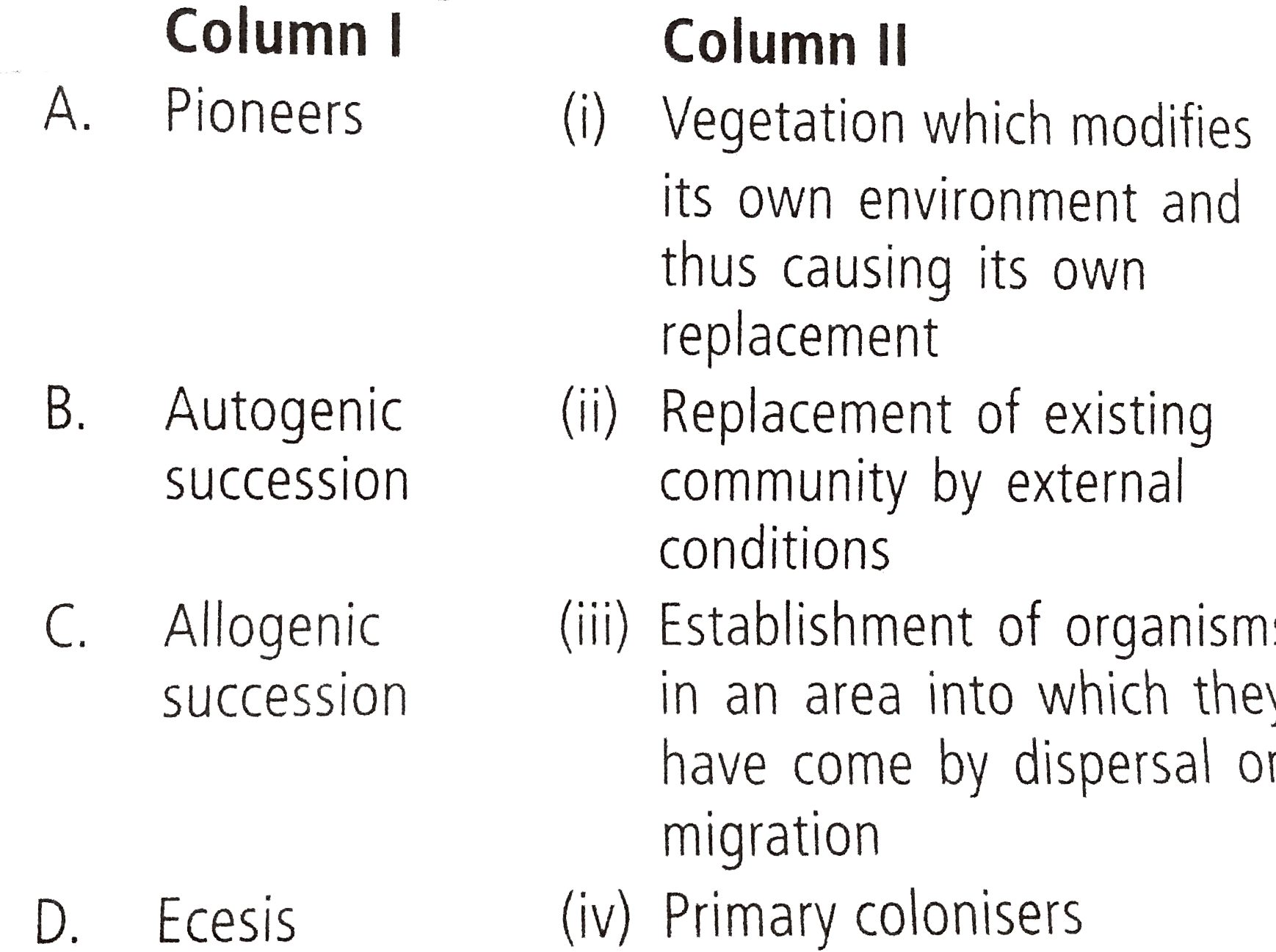Match column I withcolun II and select the correct option from the given codes.
Column IColumn IIA. Bulliform cells(i). Regulate opening and closing of stomataB. Guard cells(ii). Aerating pores in the bark of plantC. Lenticels(iii). Rolling in and out leavesD. Subsidiary cells(iv). Accessory cells
A-(iii),B-(i),C-(ii),D-(iv)
A-(i),B-(ii),C-(iii),D-(iv)
A-(iv),B-(iii),C-(i),D-(ii)
A-(ii),B-(iv),C-(iii),D-(i)
The correct Answer is:A
To solve the matching question between Column I and Column II, we will analyze each item in Column I and find its corresponding item in Column II based on their functions.
1. Identify Bulliform Cells (A):
- Bulliform cells are specialized epidermal cells found in leaves. Their main function is to help in the rolling of leaves during water stress to reduce transpiration and water loss.
- Match: Bulliform cells (A) → Rolling in and out leaves (iii).
2. Identify Guard Cells (B):
- Guard cells surround the stomata and are responsible for regulating their opening and closing. This process is crucial for gas exchange and minimizing water loss during photosynthesis.
- Match: Guard cells (B) → Regulate opening and closing of stomata (i).
3. Identify Lenticels (C):
- Lenticels are small openings in the bark of woody plants that allow for gas exchange between the internal tissues and the environment. They facilitate the entry of oxygen and the exit of carbon dioxide and water vapor.
- Match: Lenticels (C) → Aerating pores in the bark of plant (ii).
4. Identify Subsidiary Cells (D):
- Subsidiary cells are the epidermal cells that surround and support guard cells. They are often referred to as accessory cells because they assist in the function of guard cells.
- Match: Subsidiary cells (D) → Accessory cells (iv).
Final Matches:
- A → iii (Bulliform cells → Rolling in and out leaves)
- B → i (Guard cells → Regulate opening and closing of stomata)
- C → ii (Lenticels → Aerating pores in the bark of plant)
- D → iv (Subsidiary cells → Accessory cells)
Correct Option:
The correct option based on the matches is:
- A is to iii
- B is to i
- C is to ii
- D is to iv
- Bulliform cells are specialized epidermal cells found in leaves. Their main function is to help in the rolling of leaves during water stress to reduce transpiration and water loss.
- Match: Bulliform cells (A) → Rolling in and out leaves (iii).
- Guard cells surround the stomata and are responsible for regulating their opening and closing. This process is crucial for gas exchange and minimizing water loss during photosynthesis.
- Match: Guard cells (B) → Regulate opening and closing of stomata (i).
- Lenticels are small openings in the bark of woody plants that allow for gas exchange between the internal tissues and the environment. They facilitate the entry of oxygen and the exit of carbon dioxide and water vapor.
- Match: Lenticels (C) → Aerating pores in the bark of plant (ii).
- Subsidiary cells are the epidermal cells that surround and support guard cells. They are often referred to as accessory cells because they assist in the function of guard cells.
- Match: Subsidiary cells (D) → Accessory cells (iv).
- A → iii (Bulliform cells → Rolling in and out leaves)
- B → i (Guard cells → Regulate opening and closing of stomata)
- C → ii (Lenticels → Aerating pores in the bark of plant)
- D → iv (Subsidiary cells → Accessory cells)
The correct option based on the matches is:
- A is to iii
- B is to i
- C is to ii
- D is to iv
Topper's Solved these Questions
- ANATOMY OF FLOWERING PLANTSBOOK - NCERT FINGERTPS ENGLISHCHAPTER - ANATOMY OF FLOWERING PLANTSEXERCISE - Assertion & Reason
15 Videos
- ANATOMY OF FLOWERING PLANTSBOOK - NCERT FINGERTPS ENGLISHCHAPTER - ANATOMY OF FLOWERING PLANTSEXERCISE - Anatomy Of Flowering Plants
143 Videos
- ANIMAL KINGDOMBOOK - NCERT FINGERTPS ENGLISHCHAPTER - ANIMAL KINGDOMEXERCISE - Animal Kingdom
148 Videos
Similar Questions
Match column I with column II and select the correct option from the given codes.
Column IColumn IIA. Pedicel(i) Reduced leafB. Peduncle(ii) Stalk of the flowerC. Bract(iii) Stalk of the leafD. Petiole(iv) Infloresences axis
View SolutionMatch column I with column II and select the correct option from the given codes.
Column IColumn IIA. Salivary amylase(i)ProteinsB. Bile salts(ii)Milk proteinsC. Rennin(iii)StarchD. Pepsin(iv)Lipids
View Solution
Knowledge Check
Match column I with II column II and select the correct option from the given codes .
 AA-(ii), B-(iii), C-(iv), D-(i)BA-(iii), B-(ii), C-(i), D-(iv)CA-(iii), B-(ii), C-(iv), D-(i)DA-(i), B-(ii), C-(iii), D-(iv)
AA-(ii), B-(iii), C-(iv), D-(i)BA-(iii), B-(ii), C-(i), D-(iv)CA-(iii), B-(ii), C-(iv), D-(i)DA-(i), B-(ii), C-(iii), D-(iv)Match column I and II and select the correct option from the given codes.
 AA-(iii),B-(iv),C-(i), D-(v), E-(ii)BA-(iii),B-(i),C-(iv), D-(v), E-(ii)CA-(iii),B-(iv),C-(v), D-(i), E-(ii)DA-(ii),B-(iv),C-(i), D-(v), E-(iii)
AA-(iii),B-(iv),C-(i), D-(v), E-(ii)BA-(iii),B-(i),C-(iv), D-(v), E-(ii)CA-(iii),B-(iv),C-(v), D-(i), E-(ii)DA-(ii),B-(iv),C-(i), D-(v), E-(iii)Mathc column I with column II and select the correct option from the given codes.
 AA-(ii), B-(iii), C-(iv), D-(i), E-(v)BA-(v), B-(iv), C-(iii), D-(i), E-(ii)CA-(i), B-(iii), C-(iv), D-(ii), E-(v)DA-(i), B-(iv), C-(iii), D-(ii), E-(v)
AA-(ii), B-(iii), C-(iv), D-(i), E-(v)BA-(v), B-(iv), C-(iii), D-(i), E-(ii)CA-(i), B-(iii), C-(iv), D-(ii), E-(v)DA-(i), B-(iv), C-(iii), D-(ii), E-(v)
Match column I with column II and select the correct option from the given codes.
Column IColumn IIA. Bhojpatra(ii). Bark of CinchonaB. Quinine(ii). Cork of Quercus suberC. Insulators (sound proofing)(ii). Bark of betulaD. Dalchini(iv). Bark of Cinnamomum
View SolutionMatch column I with column II and select the correct option from the given codes
Column IColumn IIA. Hardwood(i). DuramenB. Soft wood(ii). AlburnumC. Heartwood(iii). Non-porous woodD. sapwood(iv). Porous wood
View SolutionMatch column I with column II and select the correct option from the codes given below
Column IColumn IIA. Psilopsida(i). PsilotumB. Lycopsida(ii). EquisetumC. Sphenopsida(iii). SelaginellaD. Pteropsida(iv). Dryopteris
View SolutionMathc column I with column II and select the correct option from the given codes.

View SolutionMathc column I with column II and select the correct option from the given codes.
Column IColumn IIMucous neck cells(i)HCl,intrinsic factorPeptic//chief cells(ii)MucusPariental//Oxyntic cells(iii)Pepsinogen
View Solution
